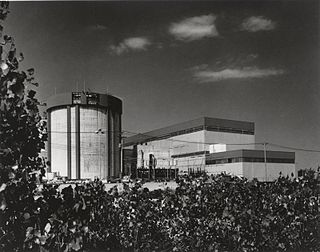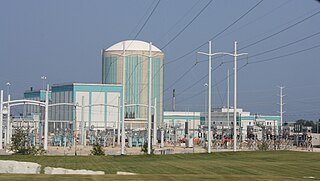
Dry cask storage is a method of storing high-level radioactive waste, such as spent nuclear fuel that has already been cooled in a spent fuel pool for at least one year and often as much as ten years. Casks are typically steel cylinders that are either welded or bolted closed. The fuel rods inside are surrounded by inert gas. Ideally, the steel cylinder provides leak-tight containment of the spent fuel. Each cylinder is surrounded by additional steel, concrete, or other material to provide radiation shielding to workers and members of the public.

The Diablo Canyon Power Plant is a nuclear power plant near Avila Beach in San Luis Obispo County, California. Following the permanent shutdown of the San Onofre Nuclear Generating Station in 2013, Diablo Canyon is now the only operational nuclear plant in California, as well as the state's largest single power station. It was the subject of controversy and protests during its construction, with nearly two thousand civil disobedience arrests in a two-week period in 1981.

Indian Point Energy Center (I.P.E.C.) is a now defunct three-unit nuclear power station located in Buchanan, just south of Peekskill, in Westchester County, New York. It sits on the east bank of the Hudson River, about 36 miles (58 km) north of Midtown Manhattan. The facility permanently ceased power operations on April 30, 2021. Before its closure, the station's two operating reactors generated about 2,000 megawatts (MWe) of electrical power, about 25% of New York City's usage. The station is owned by Holtec International, and consists of three permanently deactivated reactors, Indian Point Units 1, 2, and 3. Units 2 and 3 were Westinghouse pressurized water reactors. Entergy purchased Unit 3 from the New York Power Authority in 2000 and Units 1 and 2 from Consolidated Edison in 2001.

Oyster Creek Nuclear Power Station is an inactive single unit 636 MWe boiling water reactor power plant in the United States. The plant is located on an 800-acre (3.2 km2) site adjacent to Oyster Creek in the Forked River section of Lacey Township in Ocean County, New Jersey. At the time of its closure, the facility was owned by Exelon Corporation and, along with unit 1 at Nine Mile Point Nuclear Generating Station, was the oldest operating commercial nuclear power plant in the United States. The plant first started commercial operation on December 23, 1969, and is licensed to operate until April 9, 2029, but Oyster Creek was permanently shut down in September 2018. The plant got its cooling water from Barnegat Bay, a brackish estuary that empties into the Atlantic Ocean through the Barnegat Inlet.

The San Onofre Nuclear Generating Station (SONGS) is a permanently closed nuclear power plant located south of San Clemente, California, on the Pacific coast, in Nuclear Regulatory Commission Region IV. The plant was shut down in 2013 after defects were found in replacement steam generators; it is currently in the process of being decommissioned. The 2.2 GW of electricity supply lost when the plant shut down was replaced with 1.8 GW from new natural-gas-fired power plants and 250 MW from energy-storage projects.

The Watts Bar Nuclear Plant is a Tennessee Valley Authority (TVA) nuclear reactor pair used for electric power generation. It is located on a 1,770-acre (7.2 km²) site in Rhea County, Tennessee, near Spring City, between Chattanooga and Knoxville. Watts Bar supplies enough electricity for about 1.2 million households in the Tennessee Valley.

The Prairie Island Nuclear Generating Plant is an electricity-generating facility located in Red Wing, Minnesota, along the Mississippi River, and adjacent to the Prairie Island Indian Community reservation.

Zion Nuclear Power Station was the third dual-reactor nuclear power plant in the Commonwealth Edison (ComEd) network and served Chicago and the northern quarter of Illinois. The plant was built in 1973, and the first unit started producing power in December 1973. The second unit came online in September 1974. This power generating station is located on 257 acres (104 ha) of Lake Michigan shoreline, in the city of Zion, Lake County, Illinois. It is approximately 40 direct-line miles north of Chicago, Illinois and 42 miles (68 km) south of Milwaukee, Wisconsin.

The Fort Calhoun Nuclear Generating Station is a shut-down nuclear power plant located on 660 acres (2.7 km2) between Fort Calhoun, and Blair, Nebraska adjacent to the Missouri River between mile markers 645.6 and 646.0. The utility has an easement for another 580 acres (2.3 km2) which is maintained in a natural state. The power plant is owned by the Omaha Public Power District of Omaha, Nebraska. When operational, the plant accounted for 25 percent of OPPD's net generation capabilities.

The Enrico Fermi Nuclear Generating Station is a nuclear power plant on the shore of Lake Erie near Monroe, in Frenchtown Charter Township, Michigan on approximately 1,000 acres (400 ha). All units of the plant are operated by the DTE Energy Electric Company and owned by parent company DTE Energy. It is approximately halfway between Detroit, Michigan, and Toledo, Ohio. It is also visible from parts of Amherstburg and Colchester, Ontario as well as on the shore of Lake Erie in Ottawa County, Ohio. Two units have been constructed on this site. The first unit's construction started on August 4, 1956 and reached initial criticality on August 23, 1963, and the second unit received its construction permit on September 26, 1972. It reached criticality on June 21, 1985 and was declared commercial on November 18, 1988. The plant is connected to two single-circuit 345 kV Transmission Lines and three 120 kV lines. They are operated and maintained by ITC Transmission.

The Kewaunee Power Station is a decommissioned nuclear power plant, located on a 900 acres (360 ha) plot in the town of Carlton, Wisconsin, 27 miles (43 km) southeast of Green Bay, Wisconsin in Kewaunee County, and south of the city of Kewaunee.

The Palisades Nuclear Generating Station is a moth-balled nuclear power plant located on Lake Michigan, in Van Buren County's Covert Township, Michigan, on a 432-acre (175 ha) site 5 miles (8.0 km) south of South Haven, Michigan, USA. Palisades was operated by the Nuclear Management Company and owned by CMS Energy prior to the sale to Entergy on April 11, 2007.

Spent fuel pools (SFP) are storage pools for spent fuel from nuclear reactors. They are typically 40 or more feet (12 m) deep, with the bottom 14 feet equipped with storage racks designed to hold fuel assemblies removed from reactors. A reactor's local pool is specially designed for the reactor in which the fuel was used and is situated at the reactor site. Such pools are used for short-term cooling of the fuel rods. This allows short-lived isotopes to decay and thus reduces the ionizing radiation and decay heat emanating from the rods. The water cools the fuel and provides radiological protection from its radiation.

Yankee Rowe Nuclear Power Station was a nuclear power plant in Rowe, Massachusetts, located on the Deerfield River in the town of Rowe in western Massachusetts. Its 180 MWe pressurized water reactor operated from 1961 to 1991. It produced electricity for New England consumers. The site is referred to as "Yankee-Rowe" or simply "Rowe", to avoid confusion with Vermont Yankee, another nuclear power station located in nearby Vernon, Vermont. The decommissioning of the site was completed in 2007.
Nuclear decommissioning is the process leading to the irreversible complete or partial closure of a nuclear facility, usually a nuclear reactor, with the ultimate aim at termination of the operating licence. The process usually runs according to a decommissioning plan, including the whole or partial dismantling and decontamination of the facility, ideally resulting in restoration of the environment up to greenfield status. The decommissioning plan is fulfilled when the approved end state of the facility has been reached.

La Crosse Boiling Water Reactor (LACBWR) was a boiling water reactor (BWR) nuclear power plant located near La Crosse, Wisconsin in the small village of Genoa, in Vernon County, approximately 17 miles south of La Crosse along the Mississippi River. It was located directly adjacent to the coal-fired Genoa Station #3. The site is owned and was operated by Dairyland Power Cooperative (Dairyland). Although the reactor has been demolished and decommissioned, spent nuclear fuel is still stored at the location.

The Fukushima Daiichi Nuclear Power Plant is a disabled nuclear power plant located on a 350-hectare (860-acre) site in the towns of Ōkuma and Futaba in Fukushima Prefecture, Japan. The plant suffered major damage from the magnitude 9.1 earthquake and tsunami that hit Japan on March 11, 2011. The chain of events caused radiation leaks and permanently damaged several of its reactors, making them impossible to restart. The working reactors were not restarted after the events.
The Levy County Nuclear Power Plant was a proposed nuclear power plant in Levy County, Florida. Progress Energy Florida originally estimated that the reactors would cost $5 billion and would commence operation in 2016. It later became clear that the Levy County reactors would not have started operation until at least 2026. Since Progress filed its application for the new plant in 2008 demand for electricity had been growing very slowly, and natural gas prices were extremely low at the time. The utility estimated that the reactors would cost between $17 billion and $22 billion, not counting financing charges and cost overruns. According to economist Mark Cooper, opposition to the project has mounted, threatening a rerun of the 1970s and 1980s, when the majority of nuclear construction plans were canceled or abandoned.
SAFSTOR is a nuclear decommissioning method in which a nuclear power plant or facility governed by the United States Nuclear Regulatory Commission, is "placed and maintained in a condition that allows the facility to be safely stored and subsequently decontaminated to levels that permit release for unrestricted use".

Holtec International is a supplier of equipment and systems for the energy industry. Founded in Mount Laurel, New Jersey in 1986, Holtec International is a privately-held technology company with domestic operation centers in New Jersey, Florida, Ohio and Pennsylvania and worldwide in Brazil, India Japan, Mexico, Poland, South Africa, Spain, U.K. and Ukraine. It specializes in the design and manufacture of parts for nuclear reactors. The company sells equipment to manage spent nuclear fuel from nuclear reactors.



















